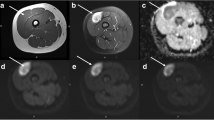Abstract
We present dynamic contrast-enhanced (DCE) and diffusion-weighted magnetic resonance imaging (MRI) features in three cases of sinonasal organized hematoma. The DCE MRI was evaluated by analyzing the time–intensity curve patterns on a pixel-by-pixel basis and diffusion-weighted MRI by analyzing the apparent diffusion coefficient maps. Preoperative information on the physiological tumor properties obtained with these MRI techniques may be useful in differentiating organized hematomas from other benign or malignant tumors or tumorlike lesions in the sinonasal area.



Similar content being viewed by others
References
Nishiguchi T, Nakamura A, Mochizuki K, Tokuhara Y, Yamane H, Inoue Y. Expansile organized maxillary sinus hematoma: MR and CT findings and review of literature. AJNR Am J Neuroradiol. 2007;28:1375–7.
Kim EY, Kim H-J, Chung S-K, Dhong H-J, Kim HY, Yim YJ, et al. Sinonasal organized hematoma: CT and MR imaging findings. AJNR Am J Neuroradiol. 2008;29:1204–8.
Eida S, Ohki M, Sumi M, Yamada T, Nakamura T. MR factor analysis: improved technology for the assessment of 2D dynamic structures of benign and malignant salivary gland tumors. J Magn Reson Imaging. 2008;27:1256–62.
Sumi M, Nakamura T. Diagnostic importance of focal defects in the apparent diffusion coefficient-based differentiation between lymphoma and squamous cell carcinoma nodes in the neck. Eur Radiol. 2009;19:975–81.
Eida S, Sumi M, Sakihama N, Takahashi H, Nakamura T. Apparent diffusion coefficient mapping of salivary gland tumors: prediction of the benignancy and malignancy. AJNR Am J Neuroradiol. 2007;28:116–21.
Zagdaniski AM, Sigal R, Bosq J, Bazin JP, Vanel D, Di Paola R. Factor analysis of medical image sequence in MR of head and neck tumors. AJNR Am J Neuroradiol. 1994;15:1359–68.
Eida S, Sumi M, Nakamura T. Multiparametric MR imaging for the differentiation between benign and malignant salivary gland tumors. J Magn Reson Imaging. 2010;31:673–9.
Lee HK, Smoker WR, Lee BJ, Kim SJ, Cho KJ. Organized hematoma of the maxillary sinus: CT findings. AJR Am J Roentgenol. 2007;188:W370–3.
Song HM, Jang YJ, Chung Y-S, Lee BJ. Organizing hematoma of the maxillary sinus. Otolaryngol Head Neck Surg. 2007;136:616–20.
Author information
Authors and Affiliations
Corresponding author
Rights and permissions
About this article
Cite this article
Sasaki, M., Nakamura, T. Pixel-based time–intensity curve analysis and apparent diffusion coefficient mapping of sinonasal organized hematomas. Oral Radiol 26, 101–105 (2010). https://doi.org/10.1007/s11282-010-0042-9
Received:
Accepted:
Published:
Issue Date:
DOI: https://doi.org/10.1007/s11282-010-0042-9




